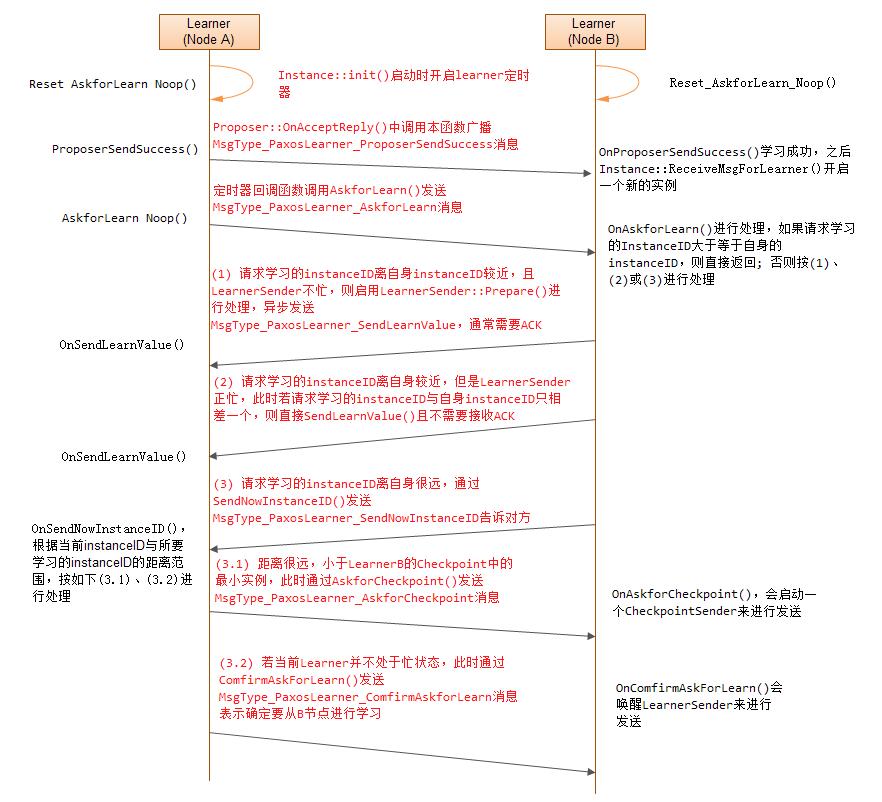phxpaxos源码分析: Learner
Paxos协议是分布式系统设计中的一个非常重要的协议,本文转载自微信后台团队公众号团队所发表一系列Paxos的文章,中间针对自己的理解略有修改或注释。在此处做一个备份,一方面为了加深对Paxos协议的理解,另一方面也方便自己的后续查找,防止文章丢失。
1. 基本概念
在Paxos中,Learner角色负责向其他节点学习选中的提案值。具体包括如下两种场景:
-
Learner所在节点参与了提案选举,Learner需要指定其接受(accept)的提案值是否被选中(chosen)
-
Learner所在的节点已落后于其他节点,Learner需要选择合适的策略快速完成追赶,并重新参与到提案选举当中。
2. 选中(chosen)通知
我们在Proposer::OnAcceptReply()函数中,当对应的提案通过时,就会调用Learner::ProposerSendSuccess()函数来发送对应的消息(MsgType_PaxosLearner_ProposerSendSuccess)来通知到各个节点:
void Learner :: ProposerSendSuccess(
const uint64_t llLearnInstanceID,
const uint64_t llProposalID)
{
BP->GetLearnerBP()->ProposerSendSuccess();
PaxosMsg oPaxosMsg;
oPaxosMsg.set_msgtype(MsgType_PaxosLearner_ProposerSendSuccess);
oPaxosMsg.set_instanceid(llLearnInstanceID);
oPaxosMsg.set_nodeid(m_poConfig->GetMyNodeID());
oPaxosMsg.set_proposalid(llProposalID);
oPaxosMsg.set_lastchecksum(GetLastChecksum());
//run self first
BroadcastMessage(oPaxosMsg, BroadcastMessage_Type_RunSelf_First);
}函数首先构造一个PaxosMsg,然后通过UDP发送到各个节点。通知的消息格式如下:
|----------------------------------------------------------------------------- | MsgType | InstanceID | NodeID | ProposalID | LastChecksum | ------------------------------------------------------------------------------
当节点收到对应消息时,就会回调到Learner :: OnProposerSendSuccess():
void Learner :: OnProposerSendSuccess(const PaxosMsg & oPaxosMsg)
{
BP->GetLearnerBP()->OnProposerSendSuccess();
PLGHead("START Msg.InstanceID %lu Now.InstanceID %lu Msg.ProposalID %lu State.AcceptedID %lu "
"State.AcceptedNodeID %lu, Msg.from_nodeid %lu",
oPaxosMsg.instanceid(), GetInstanceID(), oPaxosMsg.proposalid(),
m_poAcceptor->GetAcceptorState()->GetAcceptedBallot().m_llProposalID,
m_poAcceptor->GetAcceptorState()->GetAcceptedBallot().m_llNodeID,
oPaxosMsg.nodeid());
if (oPaxosMsg.instanceid() != GetInstanceID())
{
//Instance id not same, that means not in the same instance, ignord.
PLGDebug("InstanceID not same, skip msg");
return;
}
if (m_poAcceptor->GetAcceptorState()->GetAcceptedBallot().isnull())
{
//Not accept any yet.
BP->GetLearnerBP()->OnProposerSendSuccessNotAcceptYet();
PLGDebug("I haven't accpeted any proposal");
return;
}
BallotNumber oBallot(oPaxosMsg.proposalid(), oPaxosMsg.nodeid());
if (m_poAcceptor->GetAcceptorState()->GetAcceptedBallot()
!= oBallot)
{
//Proposalid not same, this accept value maybe not chosen value.
PLGDebug("ProposalBallot not same to AcceptedBallot");
BP->GetLearnerBP()->OnProposerSendSuccessBallotNotSame();
return;
}
//learn value.
m_oLearnerState.LearnValueWithoutWrite(
oPaxosMsg.instanceid(),
m_poAcceptor->GetAcceptorState()->GetAcceptedValue(),
m_poAcceptor->GetAcceptorState()->GetChecksum());
BP->GetLearnerBP()->OnProposerSendSuccessSuccessLearn();
PLGHead("END Learn value OK, value %zu", m_poAcceptor->GetAcceptorState()->GetAcceptedValue().size());
TransmitToFollower();
}1) 若当前Learner收到的MsgType_PaxosLearner_ProposerSendSuccess消息多对应的instanceID并不是当前Learner所期望学习的instanceID,则直接跳过;
2) 若当前Learner所对应的Acceptor并没有accept任何提案,则直接跳过;
3) 若当前Learner对应的Acceptor所accept的提案(BallotNumber)等于当前收到的PaxosMsg提案,则成功学习到所对应的提案值。
4) 将学习到的提案值发送给follower
void Learner :: TransmitToFollower()
{
if (m_poConfig->GetMyFollowerCount() == 0)
{
return;
}
PaxosMsg oPaxosMsg;
oPaxosMsg.set_msgtype(MsgType_PaxosLearner_SendLearnValue);
oPaxosMsg.set_instanceid(GetInstanceID());
oPaxosMsg.set_nodeid(m_poConfig->GetMyNodeID());
oPaxosMsg.set_proposalnodeid(m_poAcceptor->GetAcceptorState()->GetAcceptedBallot().m_llNodeID);
oPaxosMsg.set_proposalid(m_poAcceptor->GetAcceptorState()->GetAcceptedBallot().m_llProposalID);
oPaxosMsg.set_value(m_poAcceptor->GetAcceptorState()->GetAcceptedValue());
oPaxosMsg.set_lastchecksum(GetLastChecksum());
BroadcastMessageToFollower(oPaxosMsg, Message_SendType_TCP);
PLGHead("ok");
}正常情况下,所有节点处于online状态,共同参与paxos选举。因此,各个节点的instanceID一致。为了避免冲突,paxos建议只由主节点的proposer发起提案,这样保证接受提案与习得提案编号一致。
此时,Learn习得的提案值实际上就是本节点Accept的数据,因此,learn只更新内存状态即可,无需再次落盘(acceptor已经落盘)。最后,如果存在follower节点,数据同步到follower(follower节点不参与paxos算法,相当于某个paxos节点的同步备)。
3. 提案值追赶
一点节点处于落后状态,它就无法再参与到paxos提案选举中来。这时需要由learner发起主动学习完成追赶。
PhxPaxos启动时(Instance :: Init()中),会开启learner定时器。learner定时器发送learn请求到各个节点,发送请求携带本节点的instanceID,NodeID信息:
void Learner :: AskforLearn_Noop(const bool bIsStart)
{
Reset_AskforLearn_Noop();
m_bIsIMLearning = false;
m_poCheckpointMgr->ExitCheckpointMode();
AskforLearn();
if (bIsStart)
{
AskforLearn();
}
}上面AskforLearn()就会发送MsgType_PaxosLearner_AskforLearn到各个节点:
void Learner :: AskforLearn()
{
BP->GetLearnerBP()->AskforLearn();
PLGHead("START");
PaxosMsg oPaxosMsg;
oPaxosMsg.set_instanceid(GetInstanceID());
oPaxosMsg.set_nodeid(m_poConfig->GetMyNodeID());
oPaxosMsg.set_msgtype(MsgType_PaxosLearner_AskforLearn);
if (m_poConfig->IsIMFollower())
{
//this is not proposal nodeid, just use this val to bring followto nodeid info.
oPaxosMsg.set_proposalnodeid(m_poConfig->GetFollowToNodeID());
}
PLGHead("END InstanceID %lu MyNodeID %lu", oPaxosMsg.instanceid(), oPaxosMsg.nodeid());
BroadcastMessage(oPaxosMsg, BroadcastMessage_Type_RunSelf_None, Message_SendType_TCP);
BroadcastMessageToTempNode(oPaxosMsg, Message_SendType_UDP);
}注意上面是采用TCP方式向各个节点发送学习请求的。
各个节点收到请求后,Instance::OnReceive()会回调Instance::OnReceivePaxosMsg(),之后再回调到Instance::ReceiveMsgForLearner(),最后回调到如下函数:
void Learner :: OnAskforLearn(const PaxosMsg & oPaxosMsg)
{
BP->GetLearnerBP()->OnAskforLearn();
PLGHead("START Msg.InstanceID %lu Now.InstanceID %lu Msg.from_nodeid %lu MinChosenInstanceID %lu",
oPaxosMsg.instanceid(), GetInstanceID(), oPaxosMsg.nodeid(),
m_poCheckpointMgr->GetMinChosenInstanceID());
SetSeenInstanceID(oPaxosMsg.instanceid(), oPaxosMsg.nodeid());
if (oPaxosMsg.proposalnodeid() == m_poConfig->GetMyNodeID())
{
//Found a node follow me.
PLImp("Found a node %lu follow me.", oPaxosMsg.nodeid());
m_poConfig->AddFollowerNode(oPaxosMsg.nodeid());
}
if (oPaxosMsg.instanceid() >= GetInstanceID())
{
return;
}
if (oPaxosMsg.instanceid() >= m_poCheckpointMgr->GetMinChosenInstanceID())
{
if (!m_oLearnerSender.Prepare(oPaxosMsg.instanceid(), oPaxosMsg.nodeid()))
{
BP->GetLearnerBP()->OnAskforLearnGetLockFail();
PLGErr("LearnerSender working for others.");
if (oPaxosMsg.instanceid() == (GetInstanceID() - 1))
{
PLGImp("InstanceID only difference one, just send this value to other.");
//send one value
AcceptorStateData oState;
int ret = m_oPaxosLog.ReadState(m_poConfig->GetMyGroupIdx(), oPaxosMsg.instanceid(), oState);
if (ret == 0)
{
BallotNumber oBallot(oState.acceptedid(), oState.acceptednodeid());
SendLearnValue(oPaxosMsg.nodeid(), oPaxosMsg.instanceid(), oBallot, oState.acceptedvalue(), 0, false);
}
}
return;
}
}
SendNowInstanceID(oPaxosMsg.instanceid(), oPaxosMsg.nodeid());
}4. 更快的对齐数据
下述文字截取自《微信自研生产级paxos类库PhxPaxos实现原理介绍》:
上文说到当各台机器的当前运行实例编号不一致的时候,就需要Learner介入工作来对齐数据了。Learner通过其他机器拉取到当前实例的chosen value,从而跳转到下一个编号的实例,如此反复最终将自己的实例编号更新到与其他机器一致。那么这里学习一个实例的网络延时代价是一个RTT。可能这个延迟看起来还不错,但是当新的数据仍然通过一个RTT的代价不断写入的时候,而落后的机器仍然以一个RTT来进行学习,这样会出现很难追上的情况。
这里需要改进,我们可以提前获取差距,批量打包进行学习。比如A机器Learner记录当前实例编号是 x, B机器是y, 而 x<y, 那么B机器通过通信获取这个差距,将[x,y]的choosen value一起打包发送给A机器, A机器进行批量的学习。这是一个很不错的方法。
但仍然不够快,当落后的数据极大,B机器发送数据需要的网络耗时也将变大,那么发送数据的过程中,A机器处于一种空闲状态,由于paxos另外一个瓶颈在于写盘,如果不能利用这段时间来进行写盘,那性能仍然堪忧。我们参考流式传输,采用类似的方法实现Learner的边发边学,B机器源源不断的往A机器输送数据,而A机器只需要收到一个实例最小单元的包体,即可立即解开进行学习并完成写盘。
具体的实现大概是先进行一对一的协商,建立一个Session通道,在Session通道里直接采用直塞的方式无脑发送数据。当然也不是完全无脑,Session通过心跳机制进行维护,一旦Session断开即停止发送。
我们参考流式传输,采用类似的方法实现Learner的边发边学,B机器源源不断的往A机器输送数据,而A机器只需要收到一个实例最小单元的包体,即可立即解开进行学习并完成写盘。这部分实际上封装在网络层,来看如何做到A机器接收到一个最小的示例单元:
int MessageEvent :: OnRead()
{
if (m_iLeftReadLen > 0)
{
return ReadLeft();
}
int iReadLen = m_oSocket.receive(m_sReadHeadBuffer + m_iLastReadHeadPos, sizeof(int) - m_iLastReadHeadPos);
if (iReadLen == 0)
{
BP->GetNetworkBP()->TcpOnReadMessageLenError();
PLErr("read head fail, readlen %d, socket broken", iReadLen);
return -1;
}
m_iLastReadHeadPos += iReadLen;
if (m_iLastReadHeadPos < (int)sizeof(int))
{
PLImp("head read pos %d small than sizeof(int) %zu", m_iLastReadHeadPos, sizeof(int));
return 0;
}
m_iLastReadHeadPos = 0;
int niLen = 0;
int iLen = 0;
memcpy((char *)&niLen, m_sReadHeadBuffer, sizeof(int));
iLen = ntohl(niLen) - 4;
if (iLen < 0 || iLen > MAX_VALUE_SIZE)
{
PLErr("need to read len wrong %d", iLen);
return -2;
}
m_oReadCacheBuffer.Ready(iLen);
m_iLeftReadLen = iLen;
m_iLastReadPos = 0;
//second read maybe no data read, so readlen == 0 is ok.
bool bAgain = false;
iReadLen = m_oSocket.receive(m_oReadCacheBuffer.GetPtr(), iLen, &bAgain);
if (iReadLen == 0)
{
if (!bAgain)
{
PLErr("second read data fail, readlen %d, no again, socket broken", iReadLen);
return -1;
}
else
{
PLErr("second read data, readlen %d need again", iReadLen);
return 0;
}
}
if (iReadLen == iLen)
{
ReadDone(m_oReadCacheBuffer, iLen);
m_iLeftReadLen = 0;
m_iLastReadPos = 0;
}
else if (iReadLen < iLen)
{
m_iLastReadPos = iReadLen;
m_iLeftReadLen = iLen - iReadLen;
PLImp("read buflen %d small than except len %d", iReadLen, iLen);
}
else
{
PLErr("read buflen %d large than except len %d", iReadLen, iLen);
return -2;
}
return 0;
}Learner发送过来的数据包格式如下:
|------------------------------------------------ | Packet_length | Packet | | 4Byte | | -------------------------------------------------
其中Packet_length包括其本身占用的4个字节,因此实际的Packet占用的字节数为(Packet_length - 4)。
OnRead()函数由以下两部分组成:
-
首先读取数据包大小,这个过程可能需要分多次完成;
-
读取指定数据包大小的数据,这部分也可能需要分多次完成;
当单个数据包读完,已获得完整的“最小实例单元”,通过ReadDone()将数据包发往Node节点进行处理。
至于心跳,其实就是PhxPaxos中的ACK机制。在LearnerSender :: SendLearnedValue()中,每发送一条记录需要执行一次CheckAck。如果检查失败,将终止发送。每条记录发送后,LearnerSender要求对端发送一个异步的ack响应,这个过程是异步的。CheckAck()的逻辑如下:
const bool LearnerSender :: CheckAck(const uint64_t llSendInstanceID)
{
m_oLock.Lock();
if (llSendInstanceID < m_llAckInstanceID)
{
m_iAckLead = LearnerSender_ACK_LEAD;
PLGImp("Already catch up, ack instanceid %lu now send instanceid %lu",
m_llAckInstanceID, llSendInstanceID);
m_oLock.UnLock();
return false;
}
while (llSendInstanceID > m_llAckInstanceID + m_iAckLead)
{
uint64_t llNowTime = Time::GetSteadyClockMS();
uint64_t llPassTime = llNowTime > m_llAbsLastAckTime ? llNowTime - m_llAbsLastAckTime : 0;
if ((int)llPassTime >= LearnerSender_ACK_TIMEOUT)
{
BP->GetLearnerBP()->SenderAckTimeout();
PLGErr("Ack timeout, last acktime %lu now send instanceid %lu",
m_llAbsLastAckTime, llSendInstanceID);
CutAckLead();
m_oLock.UnLock();
return false;
}
BP->GetLearnerBP()->SenderAckDelay();
//PLGErr("Need sleep to slow down send speed, sendinstaceid %lu ackinstanceid %lu",
//llSendInstanceID, m_llAckInstanceID);
m_oLock.WaitTime(20);
}
m_oLock.UnLock();
return true;
}1) 若当前发送的instanceID已经小于ACK的instanceID,则直接返回false,表明不需要再继续发送了
2) 若当前已经有比较多的instanceID未被确认,则循环等待一段时间,等待ACK的到达
5. 关于选中(chosen)
在整个讲解learner中,我们一直在强调选中(chosen)提案或选中(chosen)值。这个过程提出以下疑问,并尝试解答:
1) 问: learner如何知道某个提案被选中呢?
答: 本文第2节的选中(chosen)通知是通知各个learner值是否已被选中的一种常规方式。
2) 问: 如果某个值被选中后,提案发起节点异常,选中消息未发出会如何?
答: 重新发起选举,新的被选中的提案编号不同,但提案值保持不变。
3) 问: “2 选中通知” 中,只更新了内存状态,在持久化数据中,如何区分一个值的状态时accept还是chosen呢?
答: 如果当前的instanceID为N,在N-1之前的所有提案值都是chosen的。但instanceID未N的提案值可能是chosen状态,也可能是accept状态。
4) 问: 为何非chosen状态的数据也需要落盘?
答: 参见P2C的不变性,即Prepare和Accept阶段做过的承诺、接受过的值即便节点重启等异常情况下也需要保持不变。
5) 我还有一个instance类初始化的问题
答: Instance类本章尚未涉及,我们会留在后面相关章节进行解答。
6. Learner运行流程
PhxPaxos中Learner的整体运行流程如下:

7. 总结
经过前面的讲解(Proposer、Acceptor、Learner),paxos协议的算法实现已经分析完成。Phxpaxos并未对paxos做任何变种,甚至还做了一点简化。
下一节,我们将介绍paxos made simple中另一个重要概念:状态机。当然,这里提到的简化也会提及。
参看:

